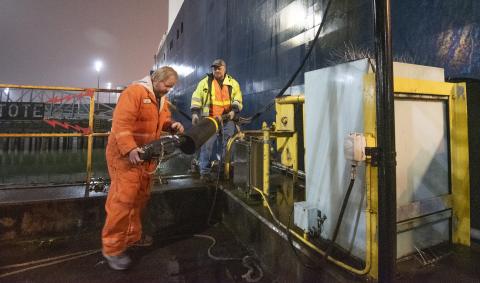
The Northwest Seaport Alliance has worked aggressively toward installing shore power infrastructure on our marine terminals for connecting container ships to the electrical grid, allowing them to shut down their engines while at dock.
About shore power
What is shore power?
Shore power is the provision of electricity from the local power grid to satisfy a ship’s energy needs while it is at berth. This allows the vessel to turn off the diesel engines that normally generate this power when the ship is at sea or docked at a terminal without shore power.
In order to provide power to ships, substantial electrical infrastructure improvements are required. A typical container ship needs a megawatt or more of power while it is docked, or roughly the equivalent of about 800 homes. To provide this power, substantial power distribution infrastructure must be installed on land including transformers, underground wiring, switchgear, and connection boxes (plug in points) in the wharf. All together, these infrastructure elements are expensive, costing from millions to tens of millions of dollars to install shore power at a container ship terminal.
In addition to needing landside infrastructure available, for a ship to use shore power, it must have special equipment installed to accept shore power. As shore power requirements are implemented in other areas, such as California, we are seeing more and more ships capable of using shore power in the Pacific Northwest.
As of 2019, an estimated 50% of the container ships calling at the NWSA’s five largest international container terminals in Tacoma and Seattle were “shore power capable”. While we are seeing an uptick in the number of container ships that are capable of using shore power, other cargo vessel types such as bulk, breakbulk, and auto carriers are generally not shore power capable.
What are the benefits of shore power?
When a ship plugs in to shore power, it can turn of its auxiliary engines, thereby reducing emissions by eliminating the need to burn fuel onboard to generate electricity. For a ship that is at dock for 40 hours, this avoids burning about 10 metric tons of marine gasoil (diesel fuel for ships) and avoids emitting about 32 tons of CO2 and 22 pounds of diesel particulate matter.
Where does the NWSA have shore power available?
Since 2010, the TOTE Terminal in Tacoma (Operated by TOTE Maritime) has been equipped with shore power. The two TOTE vessels on regular service between Tacoma and Alaska call weekly and plug in to the grid while they are at dock in Tacoma. The terminal side infrastructure was partially funded through a grant from the EPA’s Diesel Emission Reduction Act (DERA) program.
The NWSA is presently working on modernizing its Terminal 5 facility in Seattle and as part of that project, the NWSA is installing shore power at both berths. The shore power system at Terminal 5 is being partially funded by a special appropriation from the State of Washington.
In addition, the NWSA is working on adding shore power capabilities to its newly modernized Pier 3 and Pier 4 facilities in Tacoma (which together make up the Husky Terminal). The shore power system is being partially funded through grants from the EPA’s Diesel Emission Reduction Act (DERA) program and the TransAlta Coal Transition Grant Program’s Energy Technology Fund. The shore power system is expected to be ready for use by the end of 2023.
What are our future plans?
Our goal is to expand shore power capabilities to our other large international container terminals in Tacoma and Seattle. In addition to the completed and ongoing projects, this includes Terminal 18 in Seattle and Washington United Terminal and Pierce County Terminal in Tacoma. We are currently planning these projects and looking for grants and other funding to help us make these investments in clean air a reality.
